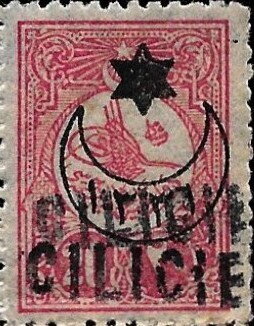Stamp: Usage courant-common use - Double Overprint (Cilicia 1919)
Usage courant-common use - Double Overprint (Cilicia 1919)
01 January (Cilicia ) within release Usage courant-common use - Double Overprint goes into circulation Stamp Usage courant-common use - Double Overprint face value 20 Turkish para
| Stamp Usage courant-common use - Double Overprint in catalogues | |
|---|---|
| Yvert et Tellier: | Yt: FR-CI 2c |
Stamp is square format.
Also in the issue Usage courant-common use - Double Overprint:
- Stamp - Usage courant-common use - Double Overprint face value 20;
- Stamp - Usage courant-common use - Double Overprint face value 20;
|
Data entry completed
46%
|
|
|---|---|
| Stamp Usage courant-common use - Double Overprint in digits | |
| Country: | Cilicia |
| Date: | 1919-01-01 |
| Emission: | Definitive |
| Format: | Stamp |
| Face Value: | 20 Turkish para |
Stamp Usage courant-common use - Double Overprint it reflects the thematic directions:
A crescent shape (/ˈkrɛsənt/, UK also /ˈkrɛzənt/) is a symbol or emblem used to represent the lunar phase (as it appears in the northern hemisphere) in the first quarter (the "sickle moon"), or by extension a symbol representing the Moon itself.
A star is a luminous spheroid of plasma held together by self-gravity. The nearest star to Earth is the Sun. Many other stars are visible to the naked eye at night; their immense distances from Earth make them appear as fixed points of light. The most prominent stars have been categorised into constellations and asterisms, and many of the brightest stars have proper names. Astronomers have assembled star catalogues that identify the known stars and provide standardized stellar designations. The observable universe contains an estimated 1022 to 1024 stars. Only about 4,000 of these stars are visible to the naked eye—all within the Milky Way galaxy.


